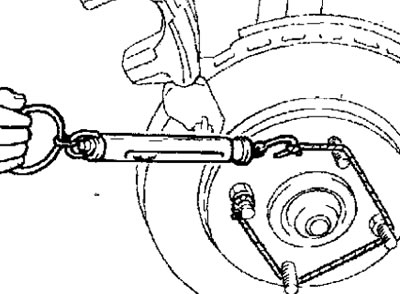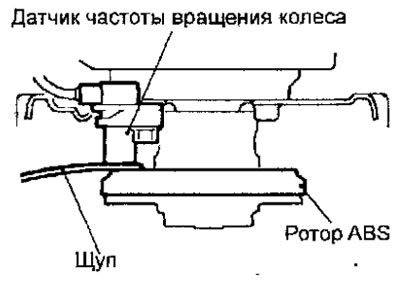Removing
1. Drain the brake fluid.
2. Disconnect the parking brake cable (pic. 15.53).

Pic. 15.53. Rear disc brake: 1 - connection of the parking brake cable; 2 - brake hose; 3 - sealing gasket; 4 - support; 5 - brake disc; 6- hub cap; 7 - self-locking nut, 175 Nm; 8 - rear wheel hub assembly; 9 - rear wheel speed sensor; 10 - support shield; 11 - disc brake adapter
3. Turn out a hollow bolt and disconnect a brake hose from a support.
4. Remove the seals.
5. Turn out bolts and remove a support.
6. Turn out bolts and remove a brake disk.
7. Using a screwdriver as a lever, remove the hub cap.
8. Turn away a self-locking nut of fastening of a nave.
9. Remove the rear wheel hub assembly.
10. Turn out bolts and remove the gauge of Frequency of rotation of a back wheel.
11. Turn out bolts and remove a basic board and an adapter of a disk brake.
Installation
Installation is carried out in the reverse order of removal, taking into account the following.
1. Using a spring dynamometer, measure the moment of resistance to rotation of the wheel bearing with the brake pads removed (pic. 15.54).

Pic. 15.54. Using a spring dynamometer to measure the moment of resistance to rotation of the wheel bearing with the brake pads removed
2. After installing the caliper assembly, install the brake pad assembly.
Warning. Keep oils, greases or other contaminants away from the running surfaces of the brake pads and brake disc.
3. If new brake pads will be installed with a special tool, press the piston into the caliper cylinder (pic. 15.55). When the piston is depressed, the brake fluid is forced out of the brake cylinder into the reservoir. Therefore, constantly monitor the fluid level in the tank and, if necessary, pump out.

Pic. 15.55. Using a special tool to press the piston into the caliper cylinder
4. Be careful not to damage the piston boot when lowering the caliper into place, then install the guide pin.
5. Start the engine and press the brake pedal 2-3 times.
6. Turn off the engine.
7 Turn the brake disc 10 turns in the forward direction.
8. Using a spring dynamometer, measure the moment of resistance to rotation of the wheel bearing (pic. 15.56).

Pic. 15.56. Using a spring dynamometer to measure the moment of resistance to rotation of a wheel bearing
9. Calculate the torque resistance of the new brake pads as the difference between the torque of the hub with brake pads and without brake pads.
Disk brake torque: max. 20 N
10. If the calculated torque difference exceeds the nominal value, remove and clean the caliper piston, and also check the condition of the caliper guide pins.
11. When installing the rear wheel speed sensor, be careful when handling the sensor tip so as not to damage it. Insert a feeler gauge into the gap between the tip of the rear wheel speed sensor and the toothed surface of the ABS sensor rotor, and verify that the gap is within specification all around the rotor (pic. 15.57).

Pic. 15.57. Checking the gap between the tip of the rear wheel speed sensor and the toothed surface of the ABS sensor rotor
Rated clearance: 0.1-1.9mm
